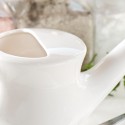Hiya Sweet Friend,
Check out this super informative guest article by Shannon Sexton from my blog archives. Happy reading—take it away Shannon! xo, Kris
Getting to Know the Nose
Before we go into the details of the nasal wash, let’s begin with a science lesson. The nostrils are the interface between your body and the atmosphere—they filter, clean, heat, and moisten the air you inhale. This is why yogis advocate breathing through the nose instead of the mouth.
The sensitive lining of the nostrils secretes mucus, which effectively traps dust, dirt, and other particles when it is moist. The mucus also contains antibodies, which help protect the body from infection or irritation by foreign materials or organisms. This is important because you inhale 18,000 to 20,000 times daily. All day the moist, sticky mucus collects dirty particles from the air you breathe and keeps it from entering the lungs. If you don’t clean this matter out of the nostrils, it will end up in your stomach, because the mucus lining of the nostrils slowly moves everything backwards until it is swallowed. What’s more, when the mucus becomes dry or laden with dust, it loses its protective function. The nasal wash dissolves and clears away dried mucus and stimulates the nasal linings to secrete fresh, moist mucus, which will help keep your nose—and the rest of your system—healthy.
How It Works
You can use the neti pot to rinse away pollen, dust, germs, and other airborne contaminants; to remove excess mucus when you’re congested; to moisturize the nasal membrane after spending time in planes or in heated or air-conditioned rooms; and to open the nostrils as you prepare for meditation.
The anatomy is simple. As holistic expert Carrie Demers, MD, explains: “Your nose is divided into two passages, and there’s a septum in between. You pour the water in one nostril, it goes around the back of the septum, and gravity helps it flow out the other side.”
The nasal wash, she says, can also prevent or treat sinus infections. “Your sinuses drain into your nasal passages through little openings called meatuses. It’s when these openings get blocked that mucus accumulates and causes pressure and infection. The neti water washes over the meatuses, keeping them open and the mucus inside the sinus cavities flowing out—the water doesn’t actually go into your sinuses.”
The Practice
If you’re wincing at the memory of getting water up your nose while swimming as a kid, don’t worry—jala neti uses a warm saline solution that’s the same temperature and salt concentration as your bodily fluids and is soothing to the sinuses. Neti pots vary in shape and size, so here’s a basic recipe: Mix one-half heaping teaspoon of pure noniodized salt with two cups of warm water until the salt dissolves completely. Adjust the mixture to your own salinity—it should taste like warm tears.
Fill your neti pot and lean over a sink, face downward. Keeping your nose slightly higher than your lips, twist your head to the left. As you breathe through the mouth, insert the spout into the upper nostril until it forms a tight (but comfortable) seal. Raise the handle of the neti pot and let the water flow through the nose and out the lower nostril. When you’ve emptied the pot, exhale through both nostrils into the sink or a tissue. (Do not close off one nostril while blowing, because this could force the water back into the ear.) Then repeat on the other side.
To clear loose mucus and water from the nose after the practice, exhale forcefully into the sink 5 to 10 times with both nostrils open and the face relaxed. Next, do a simple forward bend, turning the head from side to side as you do another round of vigorous exhalations. Remember, one of the goals of the nasal wash is to reduce excess mucus—so don’t be squeamish about blowing it out. You’ll feel better if you do.
The yogis have numerous variations of jala neti. In addition to the beginner’s nostril-to-nostril version described above, you can also learn how to pull water from your nose into your mouth, or push it from your mouth to your nose—which is especially useful if you’re away from home without your neti pot. To try the mouth-to-nose practice, fill your mouth three-quarters full with warm saline solution. Lean over the sink, facedown. To expel the water, tuck your chin toward your neck and press your entire tongue against the roof of the mouth, forcefully exhaling the saline into the sink. Keep the throat relaxed through the entire process. Repeat several times. This nasal wash reverses the natural motion of the cilia and cleans them in a different way. It also reduces postnasal drip.
[newsletter_subscribe snippet_id_form=’42098′]
Want more tips like these? Get actionable steps for living a vibrant life straight to your inbox each week:
[/newsletter_subscribe]
The Neti Pot Challenge
For those of you who are new to the nasal wash, try spending three to six days learning how to do it. Then use the neti pot every morning for a month to observe its overall effect.
Next, figure out how often you need to do it and what time of day works best for you. To check whether you would benefit from the nasal wash at any given moment, breathe deeply through both nostrils together, then through each nostril separately; if you feel any blockage, you will find the nasal wash helpful and soothing.
Here are a few more suggestions: Use the neti pot before your asana or meditation practice. Try rinsing your nose after exposure to dusty, smoky, or sooty environments and notice the relief you get from it. Anticipate allergy seasons by getting started on a regular schedule of two or more daily washes. Generally, use the pot before meals, instead of afterward, to stay in harmony with the body’s natural mucus-producing schedule.
Meet You at the Sink?
So there it is: nasal irrigation is both comical and practical. It cleanses and protects the nasal passages, counteracting the effects of environmental pollution and treating colds, allergies, and sinus problems naturally and effectively. It improves the quality of your breathing, and hence, your yoga and meditation practices. Now, that’s a pretty convincing argument, isn’t it?
Written by Shannon Sexton, Yoga+’s Editor-at-Large. Originally published in Natural Health Magazine on September 4, 2009.



Neti pots are perfectly safe if you boil the water, but what does boiling mean? When we had a Cryptosporidium outbreak in our area years ago authorities said we need to boil the water for 10 minutes. That seems like a lot, but you can make all your saline solution for a week and keep it in the fridge i.e. boil the water in a pot on the stove since most kettles shut off too soon, add 1 tsp baking soda and 1 tsp salt to a liter of boiler water put in a glass jar, put the lid on right away to keep germs out, cool and refrigerate. Then just warm up a small amount daily in the microwave.
I have never had nosebleeds but I did have a lot of sinus trouble before I starting using a neti pots. My guess is it would help, but you should discuss it with your doctor. Most are on board with the Neti pot because studies have actually shown it is as effective as using steriods for sinus infections.
We had two deaths in the area this winter from neti pots used with tap water. Please be careful.
A lot of people have gotten infections in their brain from netti potting with tap water. Make sure to boil the water first (and let it cool again).
I have the exact same neti pot as pictured above. I also use ‘neti pot salt’ from Whole Foods. One word of caution about water: YOU MUST USE DISTILLED WATER. City tap water is not safe for this purpose. http://www.npr.org/blogs/health/2011/12/19/143960631/second-neti-pot-death-from-amoeba-prompts-tap-water-warning
I tend to get nose bleeds quite frequently in the winter so I’m worried the saline solution will dry out my nose. Can you recommend an alternative solution?
Thanks!
Thanks for the link, Sue! I bought a neti pot just before the amoeba deaths hit the news and have been terrified to use it. It is reassuring to know that I just need to use boiled or distilled water to be safe.
I have a Neti Pot and love it! But WARNING. Parasites in tap water can swim into your brain while irrigating your nose. This can also happen while swimming in fresh water. It can cause death and symptoms are nearly unrecognizable. To be safe use distiller water or boil tap water to sterilize. I live in the south and this past sinus season there were some deaths from it. Google it and read more! Safely done Neti pots rock!
I don’t see anything in here about the importance of using sterilized or distilled water. There are fatal infections linked to neti-pot use! Please read before using a neti pot:
http://www.npr.org/blogs/health/2011/12/19/143960631/second-neti-pot-death-from-amoeba-prompts-tap-water-warning
Thank you so much for the good instruction. Thought about buying a neti pot, but never did. Will definately be looking for one now!!
Wasn’t there an article in the news recently that talked of someone getting a severe infection because they used tap water instead of bottled/distilled water? Is it recommended that bottled water be used?
Thanks. I was using a neti pot for awhile then got away from it. Getting it back out today.
I don’t think that everyone needs to have their own as they can be easily disinfected with peroxide but it is recommended.
does every person need their own Neti or can a family share? or is it a germy sort of thing that is bad to share?
I was recently saved from a sinus infection because of a nasal wash. It’s a squeeze bottle which works like a neti pot, but with a little more force. I was so stuffed up from a cold and I always get a sinus infection when I’m like that. I’ve had a neti pot for a while, but could never get any flow during a cold. I had to use the nasal wash a couple times each day to get it to go through, but once it did I felt 100 times better! I recommend getting both the neti and nasal wash bottle.
Fascinating – I’d never heard of this before. Just retweeted it.
Great post, thank you.
I bought an electric neti machine last year & I could not live without it now. The water is very gently forced up each nostril individually, as a chronic allergy sufferer it provides incredible relief. I really hope this practice gains in popularity so more & more people can experience the benefits of it.
I’ve been using my Neti pot for a few years since I saw it on Dr. Oz ~ It’s great! Sometimes the water feels like it goes through my sinuses and it usually squirts out my eyes. Am I doing something wrong?
I have a deviated septum. Are there any differences I should observe when using the neti pot?
I love my neti pot!! Best (small) investment ever!
Question – the article says “When you’ve emptied the pot, exhale through both nostrils into the sink or a tissue. (Do not close off one nostril while blowing, because this could force the water back into the ear.)” Is this just for netti pot usage? I always close one nostril when I blow my nose. Is that bad?
Very informative. thank you!Purchased one months ago but never used. Maybe I’ll start today!